QuestionI gotta say, I love my bleeding heart tetra! I know it sounds silly, but it's the first fish I've had that I felt had "personality." (He/she is a little on the shy side, and hides when I come to feed him; and darts like a bullet to the surface of the water to grab food.) I love the thought of getting another one...but do you think I could get away with putting the two in a 5 gal? Or would I be better off leaving the Bleeding Heart tetra lonely (but alive) and adding one of the others you suggested?
------------------------
Followup To
Question -
Sorry, Chris. Here's my original post:
As I've been seaching for info on the internet, it KILLS me to read about all the people who ignore their tank, have tons of algea and their fish are doing perfectly fine!! I feel like I've tried everything and have put an enormous amount of energy into mine...and yet all my fish keep dying. Please help, before I become part of the statistic of people who give up on their aquarium within the first year.
I've had a small (5 gal mini bow w/ filter and biowheel) freshwater aquarium for almost a year. Throughout that time, I've killed about 9 poor unfortunate fish.
One was lost when I learned the hard way about "new tank syndrome", another to learning not to keep too many fish in the tank. The only common bond has been that ALL of them, every single one, has died of fin/tail rot.
I do 1.5-2 gallon water changes about twice a month. I've tried Maracyn (2 kinds) melafix, StressX and Jungle brand Fungus Eliminator, I've cleaned the tank, changed the gravel and replaced the filter. I've tried not feeding the fish for several days, and then only every few days to be sure it was not from overfeeding, which is what I was told at the petstore.
I'm stumped and at my wits end. Why are ALL of my fish dying of fin/tail rot, no matter what I do? I only have one left (a bleeding heart tetra) who seems to be the only one that I've managed to keep alive for any extended period of time.
Could it be something in the tank? The (plastic) aquarium plants? The biowheel? I've noticed a white flaky buildup around where the electrical plug goes into the filter...could this possibly be doing something to pollute the water?
-------------------------
Followup To
Question -
Hi Chris:
To start, I had two goldfish and an algae eater. Too many fish, plus new tank...both goldfish died. The algae eater lasted a while longer.
Then I tried adding 2 guppies. (3 small fish in tank total.) Eventually, all 3 died. Guppies first.
The last batch consisted of 3 neon and 1 bleeding heart tetra. (3 tiny and 1 small fish in tank total.) All 3 neon tetras died. The bleeding heart has lasted the longest of any, and so far hasn't show signs of fin/tail rot. Yet.
I would be willing to accept that it had to do with overcrowding, however because I bought my fish in "batches", there was always a period of months or weeks that there were only 1 or 2 fish in the tank. And still the remaining fish died.
I always change the filter completely. To be honest, I have no idea how often is appropriate, but I usually wind up changing it every 2 months. I've never changed the biowheel (should I?)
The water temperature is 82 degrees. I don't use a heater, and seldom if ever turn the tank light on.
Lissa
Answer -
Hi Lissa;
Please give the previous information when asking a followup. I need to know the progression of our followups to give you accurate answers. I get up to 11 questions a day in 2 different fish categories so it's hard to remember everyone's details sometimes.
I do kind of remember your case though, but what size tank do you have?
In the meantime, here is my article on new tanks that will help you understand a little about filter maintenance and what may be happening to the fish;
**********
New Tank Syndrome or Break-in Period
So you have a new tank and you filled it up, put the filter together, mounted the heater into place and turned on the lights. You have all the plants and decorations where you want them....
You are ready for fish.
But, your filter is not ready for a full tank of fish yet.
The filter is running and moving the water and cleaning out crud, right? Of course!
But a very important part of your filter is the part you can't see. An aquarium filter removes the larger visible stuff, but it also must remove the dissolved fish waste that turns into ammonia in the water. To do this, special bacteria must grow in the filter system and on the particles of gravel in the bottom of your tank. This process occurs even on a limited scale in little fish bowls that have no filter in them.
This is "New-Tank Syndrome" or the "Break-in Period". The entire process takes 6 to 8 weeks to complete because these "nitrifying" bacteria grow quite slowly.
Start off with only one or two hardy fish (no more than 2 total inches of fish) for every ten gallons of water and don't add more until the 6 to 8 weeks has gone by. Hard to be patient, but it is worth it to keep your fish alive and healthy. As a matter of fact, the bacteria cannot develop without fish in the tank. You can let that tank sit forever without fish in it, but as soon as the first fish goes in the process begins. Avoid changing the filter pads during break-in. This removes the bacterial colonies that are essential to a balanced aquarium. You can rinse the filter pad out in a container of aquarium water. This will preserve most of the bacteria colonies while still allowing your filter to flow freely. Even using bacteria additives and water conditioners when you first set up the tank will not make a tank begin the cycle by itself. If there are no fish to provide food (fish waste) for the bacteria, the beneficial bacteria cultures will die and you will have to start the colonies all over again once fish are added to the tank. Once the tank has completed the initial cycle, you can change the filter pads every 4 weeks or so. But for now, just rinse them.
Feed your new fish VERY lightly. Any excess food will cause additional waste your system cannot afford to have right now. If you see food floating around or lying on the plants and gravel after five minutes, too much food is going into the tank. Cut back a little each time you feed until it is ALL gone 5 minutes after you feed them. Feed them once a day.
During this "break-in period" your tank will become cloudy and milky looking. You may have to tolerate this for the entire break-in period but it is only temporary. Changing 25% of the water three times a week until the break-in period is over helps a great deal. Changing water reduces the ammonia and nitrites that rise while the bacteria continues to multiply. If ammonia and/or nitrites become too high, your fish will become stressed and possibly die. Use a good water conditioner when you replace the water and make sure it is the right temperature to avoid shocking your fish.
When the break-in is over after 6 to 8 weeks and there are no nitrites or ammonia present in the water you can slowly add more fish. Add one or two every week until you reach the desired population. This allows the bacteria to adjust to the new population every time before adding more. Monitor the nitrites and ammonia to be sure they don't come up. If they do, make a 25% water change and check them again. Don't add the next fish until the levels are down again.
The safe maximum population for any size tank is one inch of adult fish for every gallon of water in the tank. Do some research to be sure of the fish you are interested in. Even though they are small when you buy them, you have to base your population calculations on full-sized adult fish. Many hobbyists have up to two inches per gallon but this can be risky. If a water quality issue arises or a disease occurs it will spread fast and furious in an over-populated tank. In any case, 25% water changes every week to two weeks are absolutely essential for the health of your fish.
Following these guidelines will help you get your new tank on the right track.
**********
Followups Welcome
At Your Service;
Chris Robbins
Come on over and join us on the freshwater fish forum at About.com to get even more information too;
http://freshaquarium.about.com/od/questionsanswers/a/naavigateforum.htm
My member name is ChrisR62. See You There!
Answer -
Hi Lissa;
I think the New Tank Syndrome and too many fish is what caused the trouble. Burning of the fins and skin from the toxins that build up in NTS is often mistaken for fin rot. Every time you change the filter media and clean or replace the gravel it makes the tank start over again from scratch. The beneficial bacteria needs time to grow and develop in order for the tank to biologically balance.
What also contributed to the difficulty in starting the tank was an unfortunate choice of fish. Goldfish just get too big and messy for a tank smaller than 10 to 20 gallons. Guppies and neons have become pretty weak from indreeding and are just not the strong fish they used to be. Better choices for a tank this size are tetras like 'black neons', cardinals, glowlight, or fish like 't-bone rasboras', cherry barbs, dwarf gouramis, otocinclus and cory cats. The most fish you should have in there is 5 inches of adult fish. Even if the fish are small when you buy them they will grow and you have to allow for that population wise.
If you want to keep your bleeding heart, you will have to get another one for him to pal around with. They are a larger type tetra (up to 3 inches) so more than two total would be too much. They are also fin nippers and really should be in a 10 gallon or larger.
Whatever you decide, keep asking questions. You'll get the hang of it and have a tank in every room before you know it...... just like me! ;-)
Followups Welcome
At Your Service;
Chris Robbins
Come on over and join us on the freshwater fish forum at About.com to get even more information too;
http://freshaquarium.about.com/od/questionsanswers/a/naavigateforum.htm
My member name is ChrisR62. See You There!
AnswerHi Lissa;
Since the fish are all schooling type fish it would be best to have two or more of the same kind. Adding another fish of a different type would make them both uncomfortable. Two bleeding hearts would be fine. Just keep up with water changes every week and don't overfeed them. Those two main things are most important.
Have fun with them!
Followups Welcome
At Your Service;
Chris Robbins

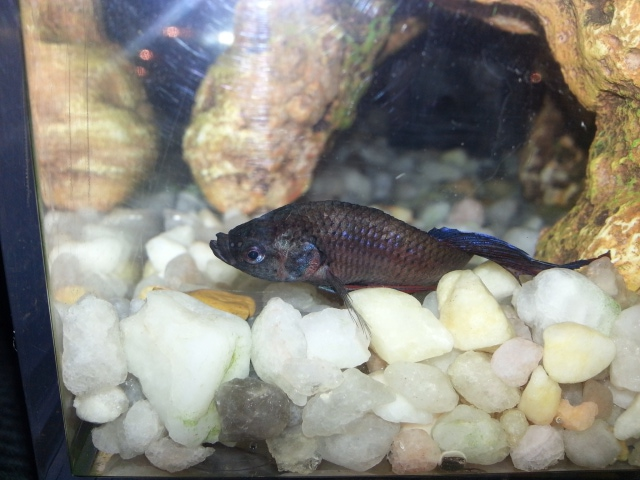 Sick Betta
Question
Image 1 Image 2
My Betta has been
Sick Betta
Question
Image 1 Image 2
My Betta has been
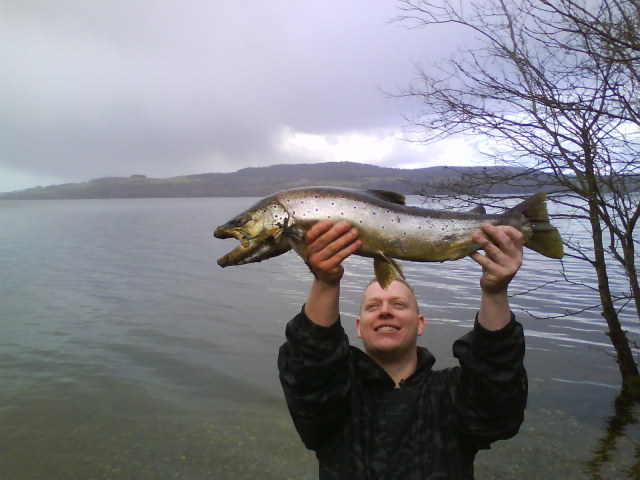 salmon or sea trout
Question
salmon or sea trout?
hi there
i caught this
salmon or sea trout
Question
salmon or sea trout?
hi there
i caught this
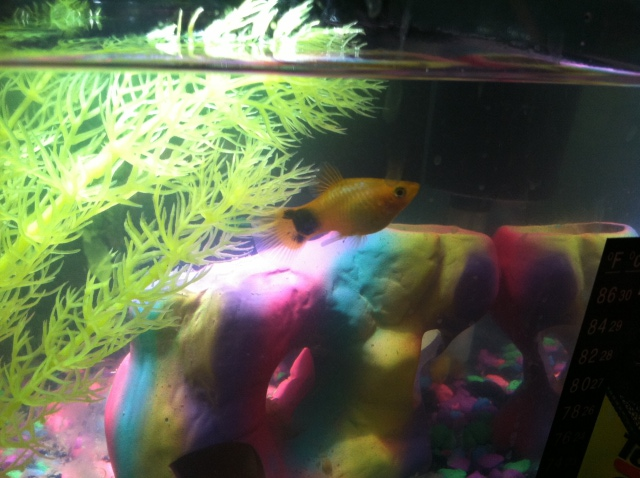 Is my neon Mickey Mouse platy moon fish pregnant
Question
Possibly pregnant
I originally bought 3
Is my neon Mickey Mouse platy moon fish pregnant
Question
Possibly pregnant
I originally bought 3
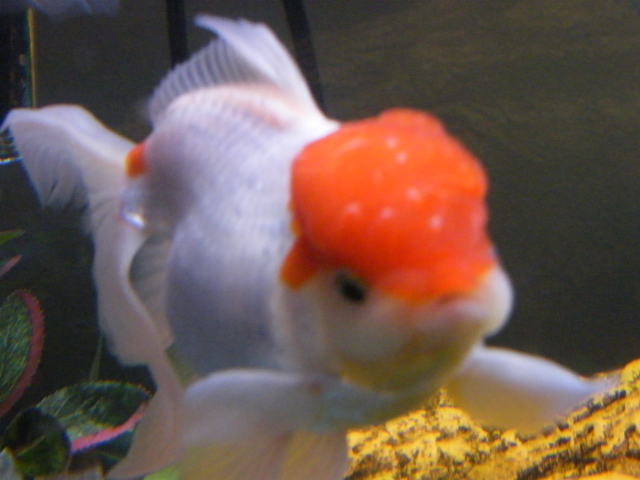 Fancy Goldfish problem
QuestionGoldfish with white fl
QUESTION: First,
Fancy Goldfish problem
QuestionGoldfish with white fl
QUESTION: First,
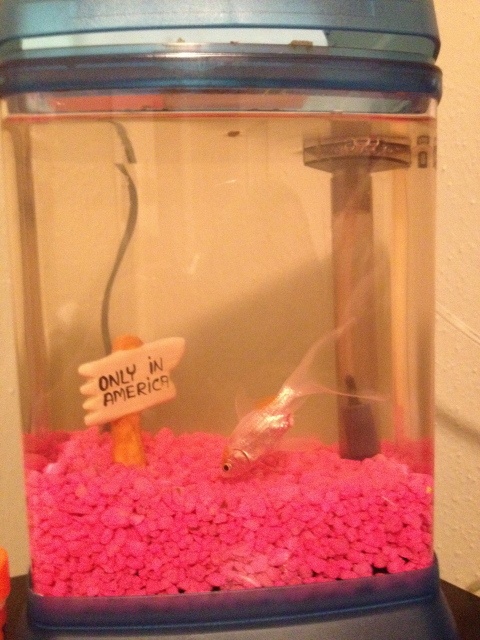 External wound on anus
Question
I have a wonderful fish that I bought
External wound on anus
Question
I have a wonderful fish that I bought